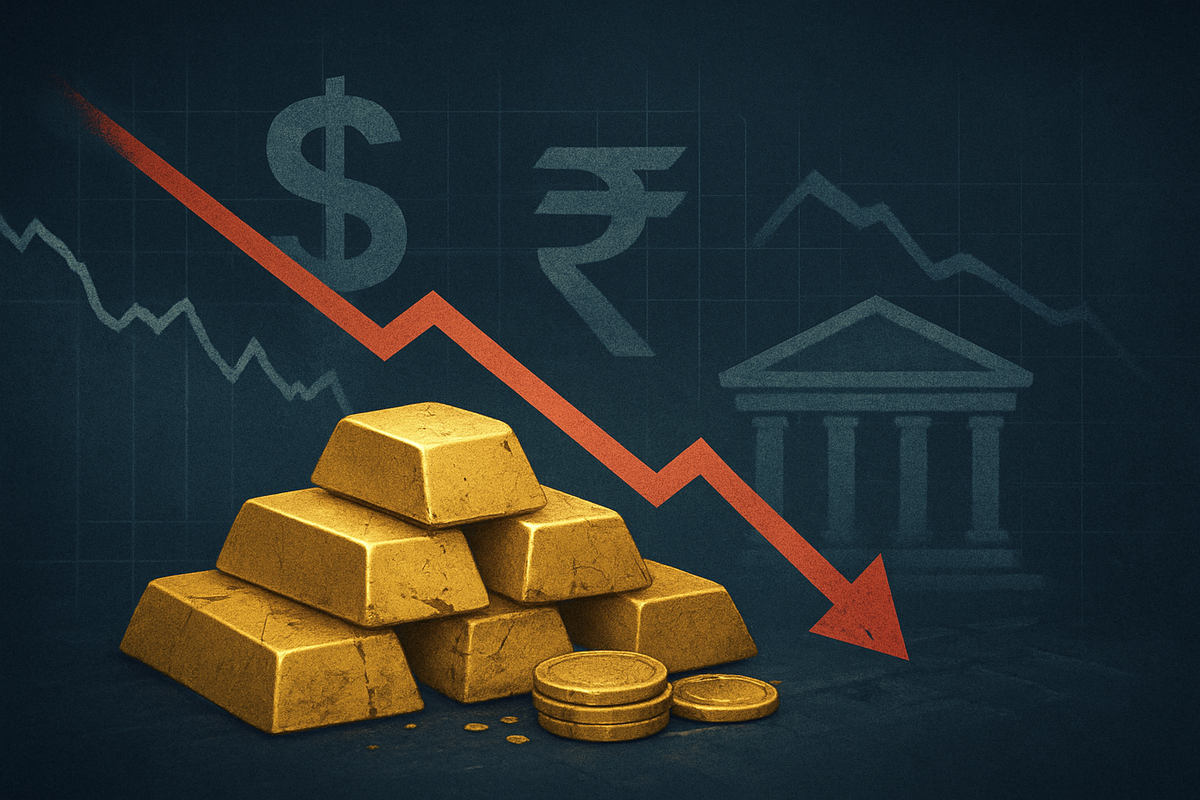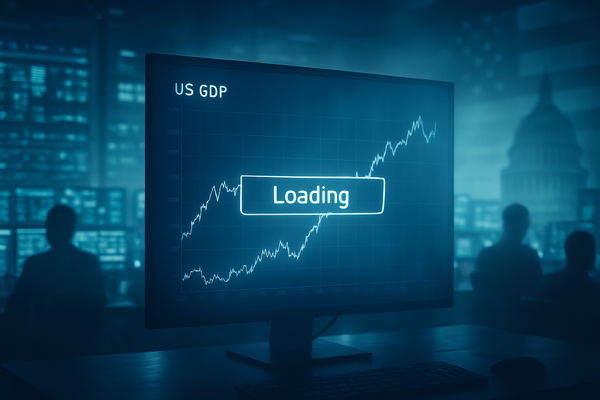Gold's Glitter Fades: A Rs 1,000 Per Tola Drop Rocks the Market

The precious metal market has witnessed a significant jolt, as gold prices in India have experienced a notable drop of approximately Rs 1,000 per tola in the first week of November 2025. This sudden downturn, representing a decline of roughly 3% in 24-carat gold from its recent highs, has sent ripples through financial circles, prompting investors and analysts to scrutinize the underlying forces at play. The immediate implication is a shift in investment sentiment, potentially redirecting capital from safe-haven assets towards other avenues, while also presenting a mixed bag of challenges and opportunities for various sectors.
This recent correction marks a notable deviation from gold's otherwise strong performance earlier in the year. The decline suggests a complex interplay of global macroeconomic factors and domestic market dynamics, challenging the long-held perception of gold as an unshakeable hedge against uncertainty. Market participants are now keenly observing whether this dip is a temporary blip or the precursor to a more sustained downward trend, with significant implications for inflation outlooks, central bank strategies, and the broader financial landscape.
Unpacking the Gold Correction: A Confluence of Global and Domestic Pressures
The significant decline in gold prices around November 2025, specifically the Rs 1,000 per tola drop, can be attributed to a confluence of robust global and domestic financial currents. The timeline leading to this moment saw gold reaching near-record highs in late October, fueled by strong seasonal demand during the Diwali festive season in India and lingering global uncertainties. However, the first week of November ushered in a correction, driven by a combination of profit-booking activities and several key macroeconomic indicators.
A primary driver for this downturn has been the strengthening of the US Dollar (USD). As gold is denominated globally in USD, a firmer dollar makes the precious metal more expensive for international buyers, thereby dampening demand and exerting downward pressure on prices. Simultaneously, a slightly appreciating Indian Rupee (INR) against the USD has made imported gold cheaper in local terms, further contributing to the domestic price reduction. This dual currency effect has been a significant headwind for gold.
Central bank policies have also played a crucial role. Despite the Federal Reserve's (Fed) announcement to halt its quantitative tightening program effective December 1, 2025 – a move generally perceived as positive for gold – the market's expectation of a "higher for longer" interest rate environment has persisted. The latest US Consumer Price Index (CPI) data for October 2025, registering at 3.5%, while above the Fed's 2% target, has led to a reduced probability of aggressive Fed rate cuts in December. Higher real interest rates increase the opportunity cost of holding non-yielding assets like gold, diverting investment towards more attractive fixed-income assets. Domestically, reduced gold purchases by the Reserve Bank of India (RBI) have also been cited as a factor in the pullback. Furthermore, easing US-China trade tensions contributed to a decline in gold's safe-haven appeal, as geopolitical stability encourages a shift towards riskier, growth-oriented assets.
Corporate Ripples: Winners and Losers in the Gold Price Dip
The recent dip in gold prices creates a distinct bifurcation of fortunes across various public companies, impacting gold miners, jewelry retailers, and financial products differently.
Gold mining companies are typically the most directly exposed to price fluctuations. A sharp drop in gold prices directly translates into reduced revenue and compressed profit margins. Miners with higher "all-in sustaining costs" (AISC) will feel the pinch most acutely, potentially rendering some operations unprofitable and challenging their ability to fund exploration and development projects. Major global players like Newmont Corporation (NYSE: NEM, TSX: NGT) and Barrick Gold Corporation (NYSE: GOLD, TSX: ABX) will see their earnings directly impacted, potentially affecting their stock performance and dividend policies. Similarly, Agnico Eagle Mines Limited (NYSE: AEM, TSX: AEM) and AngloGold Ashanti plc (NYSE: AU, ASX: AGG) are likely to experience margin compression and re-evaluation of their growth strategies. Even streaming companies like Wheaton Precious Metals Corp. (NYSE: WPM), which purchase a fixed percentage of production at low pre-set prices, will see the value of the metals they receive and sell decrease, affecting their profitability.
For gold jewelry retail companies, the impact is more nuanced. While the value of their existing gold inventory will decline, potentially affecting balance sheets, the lower cost of acquiring new gold inventory could improve future profit margins if they maintain existing price points. However, high gold prices have historically dampened consumer demand for jewelry. A sustained period of lower gold prices could stimulate demand, especially in markets like India during wedding and festive seasons. Companies like Signet Jewelers Limited (NYSE: SIG), the world's largest diamond jewelry retailer with significant gold offerings, and India's Kalyan Jewellers India Limited (NSE: KALYANKJIL) will face inventory valuation challenges but could also benefit from renewed consumer interest if prices remain attractive. Chow Tai Fook Jewellery Group Ltd. (HKEX: 1929), a leading retailer in Hong Kong and mainland China, could also see a boost in consumer purchasing.
Gold-backed financial products, primarily Exchange Traded Funds (ETFs), will see their values directly reflect the underlying gold price. Funds like SPDR Gold Shares (NYSE Arca: GLD) and iShares Gold Trust (NYSE Arca: IAU), which are physically-backed, will experience a direct and proportional decrease in their Net Asset Value (NAV) and share price. Conversely, ETFs that invest in gold mining companies, such as the VanEck Gold Miners ETF (NYSE Arca: GDX), could see an amplified decline in their share prices due to the leveraged nature of mining stocks relative to the commodity.
Broader Implications: A Shifting Landscape for Safe Havens and Investment
The recent drop in gold prices is more than just a momentary blip; it signals a potential shift in broader industry trends and investment paradigms. Gold's traditional role as the ultimate safe-haven asset is being re-evaluated in an environment where central banks are committed to reining in inflation, and geopolitical tensions, while still present, are showing signs of episodic de-escalation. This event fits into a trend where global liquidity conditions, driven by central bank actions, increasingly dictate asset flows. The "higher for longer" interest rate narrative, particularly from the US Federal Reserve, is a powerful force, making yield-bearing assets more attractive compared to non-yielding gold.
The ripple effects extend beyond the immediate gold market. Competitors in the safe-haven space, such as government bonds, may see increased demand if real interest rates continue to rise. For partners in the supply chain, from refiners to logistics providers, lower gold prices could lead to reduced transaction volumes and margins. Regulatory bodies might also pay closer attention to market volatility, especially if significant price swings impact financial stability or consumer confidence in gold as an investment. Historically, periods of strong economic growth and rising interest rates have often seen gold underperform. The current scenario draws parallels to previous cycles where robust economic data and hawkish central bank stances diminished gold's luster. For instance, in the late 1990s and early 2000s, a strong dollar and relatively stable inflation kept gold prices subdued for an extended period.
The easing of US-China trade tensions, while beneficial for global trade and economic growth, directly reduces one of the key drivers for gold demand as a hedge against economic uncertainty. This highlights how geopolitical stability, or the perception thereof, can quickly alter investment flows. The current scenario underscores a recalibration of risk appetites, where investors are increasingly willing to move capital into growth-oriented assets rather than holding onto traditional safe havens.
What Comes Next: Navigating the Evolving Gold Market
Looking ahead, the gold market faces a period of heightened scrutiny and potential volatility. In the short-term, gold prices are likely to remain sensitive to incoming economic data, particularly inflation reports and central bank communications. Any indication of a more dovish stance from the Federal Reserve or a resurgence of significant geopolitical risks could provide a floor for gold prices, potentially triggering a rebound. Conversely, stronger-than-expected economic growth and persistent hawkish rhetoric could lead to further downward pressure. Investors might see continued profit-booking and a reallocation of funds towards equities or fixed-income instruments offering better yields.
In the long-term, the outlook for gold remains complex. While current headwinds are strong, many analysts still anticipate gold prices to trend upward through 2026, albeit with more measured gains. This long-term optimism is often underpinned by persistent macroeconomic risks, such as high global debt levels, potential for future inflationary pressures, and unforeseen geopolitical events that could reignite safe-haven demand. Potential strategic pivots for gold mining companies might include cost-cutting measures, optimizing existing operations, and focusing on high-grade reserves to maintain profitability amidst lower prices. Jewelry retailers might adapt by emphasizing design innovation and marketing to stimulate demand, potentially benefiting from lower raw material costs to improve margins.
Market opportunities could emerge for contrarian investors looking to buy gold or gold-related assets on dips, anticipating a future rebound. Challenges will include navigating sustained periods of dollar strength and high real interest rates. Potential scenarios range from a rapid recovery if global uncertainties escalate or central banks pivot to a more accommodative stance, to a prolonged period of consolidation if the current macroeconomic environment persists. The role of central banks, particularly their future gold purchasing habits, will also be a critical factor. While the RBI recently reduced its purchases, other central banks might continue to diversify their reserves, offering some support to global demand.
Wrapping Up: Gold's Enduring Value in a Dynamic Market
The recent Rs 1,000 per tola drop in gold prices serves as a potent reminder of the dynamic nature of financial markets and the multifaceted factors that influence commodity valuations. The key takeaways from this event underscore the significant impact of currency strength, inflation outlooks, and central bank monetary policies on gold's appeal. The strengthening US dollar, the "higher for longer" interest rate narrative from the Federal Reserve, and easing geopolitical tensions have collectively reduced gold's allure as both an inflation hedge and a safe-haven asset in the short term.
Moving forward, the market will assess whether this correction is a healthy recalibration or the beginning of a more significant downtrend. While gold's intrinsic value and its historical role as a store of wealth remain, its short-to-medium term performance will be heavily dictated by the evolving global macroeconomic landscape. For investors, the event highlights the importance of diversification and a nuanced understanding of gold's drivers beyond simple safe-haven narratives.
In the coming months, investors should closely watch several key indicators: the trajectory of the US dollar, future inflation data from major economies, and any shifts in central bank rhetoric regarding interest rates and quantitative easing/tightening. Geopolitical developments, particularly in major economic blocs, will also continue to play a role in shaping risk sentiment. While the glitter may have momentarily dulled, gold's enduring significance in a diversified portfolio will depend on its ability to adapt to, and reflect, the ever-changing global financial environment.
This content is intended for informational purposes only and is not financial advice



